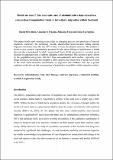Files in this item
Mobile no more? The innovative use of administrative data linked to a census-based longitudinal study to investigate migration within Scotland
Item metadata
| dc.contributor.author | McCollum, David | |
| dc.contributor.author | Ernsten, Annemarie | |
| dc.contributor.author | Feng, Zhiqiang | |
| dc.contributor.author | Everington, Dawn | |
| dc.date.accessioned | 2022-01-27T00:38:12Z | |
| dc.date.available | 2022-01-27T00:38:12Z | |
| dc.date.issued | 2020-01-27 | |
| dc.identifier | 264572369 | |
| dc.identifier | 4c69b88d-5712-47ee-97c5-8b0b7e94188a | |
| dc.identifier | 85078661261 | |
| dc.identifier | 000509486700001 | |
| dc.identifier.citation | McCollum , D , Ernsten , A , Feng , Z & Everington , D 2020 , ' Mobile no more? The innovative use of administrative data linked to a census-based longitudinal study to investigate migration within Scotland ' , Population, Space and Place , vol. Early View , e2312 . https://doi.org/10.1002/psp.2312 | en |
| dc.identifier.issn | 1544-8444 | |
| dc.identifier.other | ORCID: /0000-0001-8716-6852/work/68281532 | |
| dc.identifier.uri | https://hdl.handle.net/10023/24760 | |
| dc.description | This research was funded through the ESRC Secondary Data Analysis Initiative (grant number ES/N011430/1). We acknowledge the help provided by the staff of the Longitudinal Studies Centre - Scotland (LSCS). The LSCS is supported by the ESRC/JISC, the Scottish Funding Council, the Chief Scientist's Office and the Scottish Government. | en |
| dc.description.abstract | This paper builds upon existing scholarship on changing patterns and processes of internal migration, especially the surprising recently documented trend towards falling internal migration intensities since the late 20th century in many developed countries. The analysis is based on new research opportunities presented by the recent linking of administrative health data into the census‐based Scottish Longitudinal Study and points to a modest recent decrease in aggregate rates of address changing within Scotland. This decline is partly driven by the population subgroups that have been conventionally most mobile, especially over longer distances, becoming less migratory. This supports the notion of an evening out of some of the main socio‐economic determinants of migration and validates calls for a greater emphasis on the drivers and consequences of population immobility within migration studies. | |
| dc.format.extent | 645491 | |
| dc.language.iso | eng | |
| dc.relation.ispartof | Population, Space and Place | en |
| dc.subject | Administrative data | en |
| dc.subject | Data linkage | en |
| dc.subject | Internal migration | en |
| dc.subject | Residential mobility | en |
| dc.subject | Scottish Longitudinal Study | en |
| dc.subject | G Geography (General) | en |
| dc.subject | 3rd-DAS | en |
| dc.subject | BDP | en |
| dc.subject | R2D | en |
| dc.subject.lcc | G1 | en |
| dc.title | Mobile no more? The innovative use of administrative data linked to a census-based longitudinal study to investigate migration within Scotland | en |
| dc.type | Journal article | en |
| dc.contributor.sponsor | Economic & Social Research Council | en |
| dc.contributor.institution | University of St Andrews. School of Geography & Sustainable Development | en |
| dc.identifier.doi | https://doi.org/10.1002/psp.2312 | |
| dc.description.status | Peer reviewed | en |
| dc.date.embargoedUntil | 2022-01-27 | |
| dc.identifier.grantnumber | ES/N011430/1 | en |
This item appears in the following Collection(s)
Items in the St Andrews Research Repository are protected by copyright, with all rights reserved, unless otherwise indicated.

